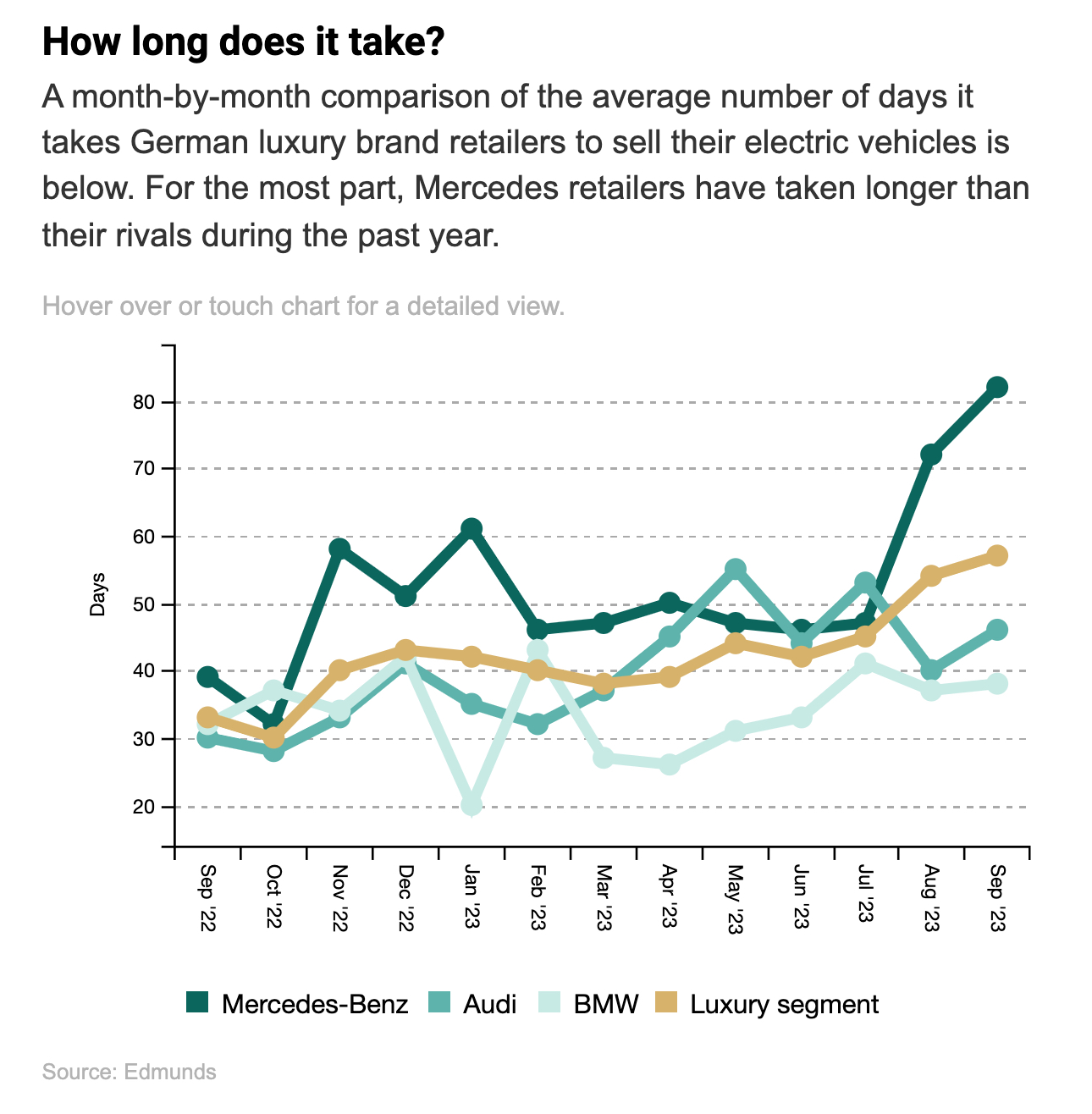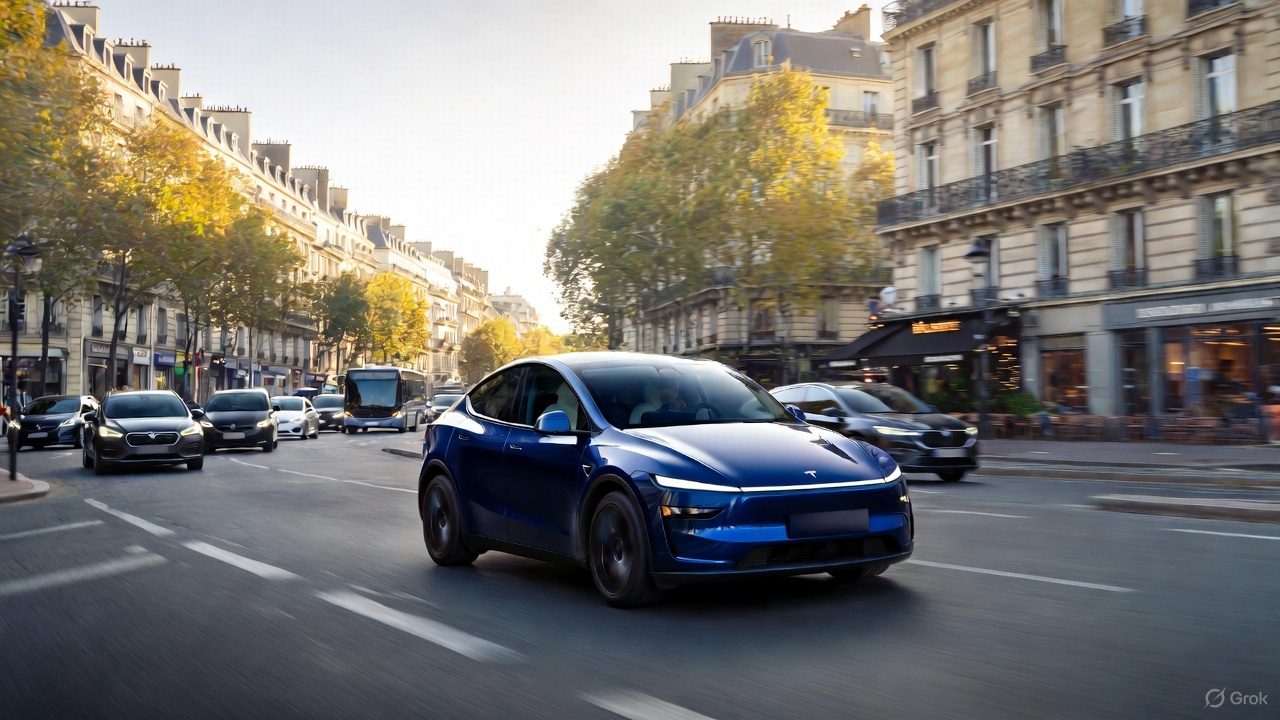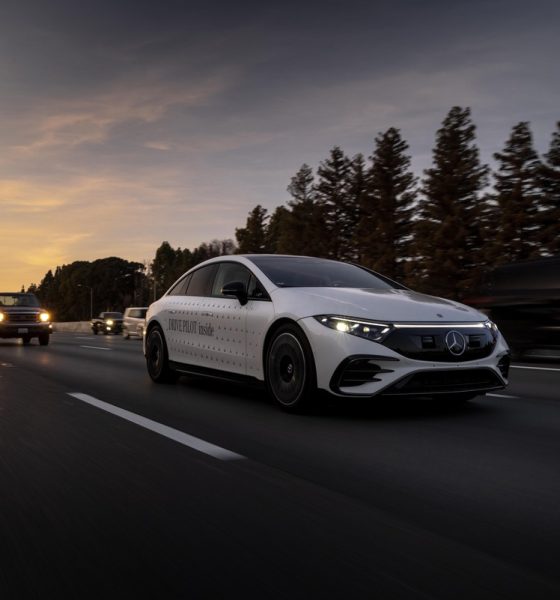Mercedes-Benz has seen the sale of its electric vehicles (EVs) increase significantly in the U.S. this year. However, a new report shows that dealers have had difficulty keeping up with inventory levels for the automaker’s EQ lineup, with sales times for the EVs exceeding the luxury segment average.
In the third quarter, Mercedes sold 10,423 EVs in the U.S., marking a 284-percent increase year over year. Despite the gradual increase in EV sales, the German automaker’s EVs are sitting on dealership lots and are not being sold off as quickly as other vehicles.
According to a report from Automotive News citing Edmunds data, Mercedes-Benz battery-electric EQ models took an average of 82 days to sell at dealerships in September. Comparatively, vehicles across the overall luxury segment averaged 57 days, while BMW vehicles took around 38 days to sell.
In various anonymous interviews with Automotive News, Mercedes dealers pointed to the brand’s lack of effort in responding to growing EV competition with sales programs and to the products themselves as the reasons for heightened inventory levels. One person who runs a Mercedes store said he currently has over six months’ worth of EVs and only a 50-day supply of the company’s gas cars.
“The EVs are coming whether or not you asked for them or earned them,” the retail store operator said. “There is too much of a price premium — especially at the top end of the EQ lineup — and almost no [lease] support.”
He added that the EQ models didn’t have the same “lust factor” as some of the automaker’s classic gas cars, including the S-Class sedan and the AMG-GT coupe.
“Our cars need to be ‘want’ cars,” he said. “The S-Class has maintained good loyalty because it’s aspirational. An EQS is not something that most people aspire to own.”
Credit: Automotive News
A Mercedes spokesperson declined to comment on internal discussions with its retailers.
CEO of Mercedes-Benz U.S., Dimitris Psillakis, blamed slow sales on a lack of product variety and on the EV segment being so new. Additionally, he pointed to issues in the supply chain as preventing variety at dealerships and keeping some more affordable models, such as the EQB compact EV, off of their lots.
“We are with a new lineup in a new world,” Psillakis said. “There is no past, there is no experience. We still face challenges around our product lines and have some restrictions coming from suppliers. We don’t always get the volume we want when we want it.”
Psillakis also said that Mercedes didn’t have any supply of the affordable EQB at the beginning of the year. Although this has changed, he says that it still takes time for the EV to reach dealers.
The Mercedes-Benz EV lineup and pricing structure is as follows, according to the automaker’s website:
- EQB (SUV); starts at $52,750
- EQE (sedan); starts at $74,900
- EQE (SUV); starts at $77,900
- EQS (sedan); starts at $104,400
- EQS (SUV); starts at $104,400
Other automakers have also faced difficulty in moving EVs alongside inflation and rising interest rates, and especially in the luxury segment.
The average EV overall sold in 36 days near the beginning of this year, according to a Cloud Theory report cited by Automotive News. By September, the report showed that this number had jumped to 80 days.
The problem is even worse for Mercedes and in the luxury segment overall. The average luxury EV sales time across brands increased by 73 percent in September compared to the same month last year, according to the aforementioned Edmunds data. For Mercedes dealers, the rate increased by 110 percent year over year.
“The ship of early adopters — willing to put a reservation down on virtually any EV announced — has sailed,” says Edmunds Insights Director Ivan Drury.
The report comes after Mercedes delayed its internal goals for electrification earlier this year, now aiming to reach a milestone of half of its auto sales being plug-in hybrids or fully electric by 2026 instead of a year prior. It also comes after Mercedes joined other automakers in adopting Tesla’s charging hardware, dubbed the North American Charging Standard (NACS).
Mercedes-Benz to launch Level 3 automated driving tech in the US by Q4
What are your thoughts? Let me know at zach@teslarati.com, find me on X at @zacharyvisconti, or send your tips to us at tips@teslarati.com.

News
Man credits Grok AI with saving his life after ER missed near-ruptured appendix
The AI flagged some of the man’s symptoms and urged him to return to the ER immediately and demand a CT scan.

A 49-year-old man has stated that xAI’s Grok ended up saving his life when the large language model identified a near-ruptured appendix that his first ER visit dismissed as acid reflux.
After being sent home from the ER, the man asked Grok to analyze his symptoms. The AI flagged some of the man’s symptoms and urged him to return immediately and demand a CT scan. The scan confirmed that something far worse than acid reflux was indeed going on.
Grok spotted what a doctor missed
In a post on Reddit, u/Tykjen noted that for 24 hours straight, he had a constant “razor-blade-level” abdominal pain that forced him into a fetal position. He had no fever or visible signs. He went to the ER, where a doctor pressed his soft belly, prescribed acid blockers, and sent him home.
The acid blockers didn’t work, and the man’s pain remained intense. He then decided to open a year-long chat he had with Grok and listed every detail that he was experiencing. The AI responded quickly. “Grok immediately flagged perforated ulcer or atypical appendicitis, told me the exact red-flag pattern I was describing, and basically said “go back right now and ask for a CT,” the man wrote in his post.
He copied Grok’s reasoning, returned to the ER, and insisted on the scan. The CT scan ultimately showed an inflamed appendix on the verge of rupture. Six hours later, the appendix was out. The man said the pain has completely vanished, and he woke up laughing under anesthesia. He was discharged the next day.
How a late-night conversation with Grok got me to demand the CT scan that saved my life from a ruptured appendix (December 2025)
byu/Tykjen ingrok
AI doctors could very well be welcomed
In the replies to his Reddit post, u/Tykjen further explained that he specifically avoided telling doctors that Grok, an AI, suggested he get a CT scan. “I did not tell them on the second visit that Grok recommended the CT scan. I had to lie. I told them my sister who’s a nurse told me to ask for the scan,” the man wrote.
One commenter noted that the use of AI in medicine will likely be welcomed, stating that “If AI could take doctors’ jobs one day, I will be happy. Doctors just don’t care anymore. It’s all a paycheck.” The Redditor replied with, “Sadly yes. That is what it felt like after the first visit. And the following night could have been my last.”
Elon Musk has been very optimistic about the potential of robots like Tesla Optimus in the medical field. Provided that they are able to achieve human-level articulation in their hands, and Tesla is able to bring down their cost through mass manufacturing, the era of AI-powered medical care could very well be closer than expected.
News
Tesla expands Model 3 lineup in Europe with most affordable variant yet
The Model 3 Standard still delivers more than 300 miles of range, potentially making it an attractive option for budget-conscious buyers.

Tesla has introduced a lower-priced Model 3 variant in Europe, expanding the lineup just two months after the vehicle’s U.S. debut. The Model 3 Standard still delivers more than 300 miles (480 km) of range, potentially making it an attractive option for budget-conscious buyers.
Tesla’s pricing strategy
The Model 3 Standard arrives as Tesla contends with declining registrations in several countries across Europe, where sales have not fully offset shifting consumer preferences. Many buyers have turned to options such as Volkswagen’s ID.3 and BYD’s Atto 3, both of which have benefited from aggressive pricing.
By removing select premium finishes and features, Tesla positioned the new Model 3 Standard as an “ultra-low cost of ownership” option of its all-electric sedan. Pricing comes in at €37,970 in Germany, NOK 330,056 in Norway, and SEK 449,990 in Sweden, depending on market. This places the Model 3 Standard well below the “premium” Model 3 trim, which starts at €45,970 in Germany.
Deliveries for the Standard model are expected to begin in the first quarter of 2026, giving Tesla an entry-level foothold in a segment that’s increasingly defined by sub-€40,000 offerings.
Tesla’s affordable vehicle push
The low-cost Model 3 follows October’s launch of a similarly positioned Model Y variant, signaling a broader shift in Tesla’s product strategy. While CEO Elon Musk has moved the company toward AI-driven initiatives such as robotaxis and humanoid robots, lower-priced vehicles remain necessary to support the company’s revenue in the near term.
Reports have indicated that Tesla previously abandoned plans for an all-new $25,000 EV, with the company opting to create cheaper versions of existing platforms instead. Analysts have flagged possible cannibalization of higher-margin models, but the move aims to counter an influx of aggressively priced entrants from China and Europe, many of which sell below $30,000. With the new Model 3 Standard, Tesla is reinforcing its volume strategy in Europe’s increasingly competitive EV landscape.
News
Tesla FSD (Supervised) stuns Germany’s biggest car magazine
FSD Supervised recognized construction zones, braked early for pedestrians, and yielded politely on narrow streets.

Tesla’s upcoming FSD Supervised system, set for a European debut pending regulatory approval, is showing notably refined behavior in real-world testing, including construction zones, pedestrian detection, and lane changes, as per a recent demonstration ride in Berlin.
While the system still required driver oversight, its smooth braking, steering, and decision-making illustrated how far Tesla’s driver-assistance technology has advanced ahead of a potential 2026 rollout.
FSD’s maturity in dense city driving
During the Berlin test ride with Auto Bild, Germany’s largest automotive publication, a Tesla Model 3 running FSD handled complex traffic with minimal intervention, autonomously managing braking, acceleration, steering, and overtaking up to 140 km/h. It recognized construction zones, braked early for pedestrians, and yielded politely on narrow streets.
Only one manual override was required when the system misread a converted one-way route, an example, Tesla stated, of the continuous learning baked into its vision-based architecture.
Robin Hornig of Auto Bild summed up his experience with FSD Supervised with a glowing review of the system. As per the reporter, FSD Supervised already exceeds humans with its all-around vision. “Tesla FSD Supervised sees more than I do. It doesn’t get distracted and never gets tired. I like to think I’m a good driver, but I can’t match this system’s all-around vision. It’s at its best when both work together: my experience and the Tesla’s constant attention,” the journalist wrote.
Tesla FSD in Europe
FSD Supervised is still a driver-assistance system rather than autonomous driving. Still, Auto Bild noted that Tesla’s 360-degree camera suite, constant monitoring, and high computing power mark a sizable leap from earlier iterations. Already active in the U.S., China, and several other regions, the system is currently navigating Europe’s approval pipeline. Tesla has applied for an exemption in the Netherlands, aiming to launch the feature through a free software update as early as February 2026.
What Tesla demonstrated in Berlin mirrors capabilities already common in China and the U.S., where rival automakers have rolled out hands-free or city-navigation systems. Europe, however, remains behind due to a stricter certification environment, though Tesla is currently hard at work pushing for FSD Supervised’s approval in several countries in the region.










